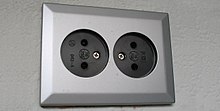Connector type C
Two- pin plugs and sockets without protective contact are referred to as plug type C. Typical is the use of round pins with a diameter of 4 to 5 mm for the connectors, in contrast to the American connector types A and B with flat pins. Plug of the type C are commonly connected to a voltage 220-240 V operated. The Type C designation follows the classification of the United States Department of Commerce . Internationally, this plug form is specified in the CEE system in the CEE 7/16 standard.
Current Type-C connector
Aside from historical designs, type C plugs in the form of the euro and contour plugs are used.
Old French and German two-pin sockets
The two-pole forerunners of today's French and German sockets as well as the types used in many other European countries (Belgium, the Netherlands, Austria and others) are very similar. This is why the three-pin (earthed) plugs developed later fit into the old sockets - but not the old plugs into the new earthed sockets. The old Type C plugs looked similar to the old Soviet plugs, but had thicker pins.
The pin spacing is 19 mm, the pin thickness 5 mm.
Russian plug
In Russia and the other states that emerged from the former Soviet Union , the old plug system for 250 V with a maximum of 6 A without earth contact is often still used. The distance between the pins is 19 mm and the pin thickness is 4 mm. There are no cutouts for Schuko or the French sockets.
Type-C plug contacts on tube radios
There are also two-pole plug contacts on tube radios of historical importance , which also have two 4 mm sockets and are classified as type C plugs. The distance between the outer pins of the connector is usually 19 mm. Often these have a medium protective pin. If this is missing, the plug can be accidentally plugged into the mains socket. This leads to the destruction of the components.
Usually speakers , antennas and other things were connected with it. In the past, DC voltage or lower voltage were sometimes connected via similar sockets. Because of the high risk of confusion, they should no longer be used.
Use of sockets without a protective conductor
These sockets are now being offered for sale again without a protective conductor; although these have a CE mark , they do not have a VDE mark. For laboratory purposes after an isolating transformer or in the case of 12-volt-to-230-V converters, i.e. without reference to earth, type C plug sockets are quite useful. Installation in buildings is not recommended due to the applicable regulations in Germany. It is true that residual current circuit breakers can be operated in front of it without any problems and the connection of devices of protection class 2 and 3 with Euro plugs is permitted, but it cannot be prevented that protection class 1 devices - which require a protective conductor - are connected.
See also
Individual evidence
- ↑ US Department of Commerce International Trade Administration (Ed.): Electric Current Abroad . February 2002 ( doc.gov [PDF; 246 kB ; accessed on July 5, 2013]). Electric Current Abroad ( April 5, 2012 memento on WebCite )
- ↑ radio socket? DC socket? In: Radiomuseum.org Forum. January 2007, accessed October 24, 2012 .
- ↑ korting: Second loudspeaker requires its own transformer. In: Radiomuseum.org forum. November 2006, accessed October 24, 2012 .





